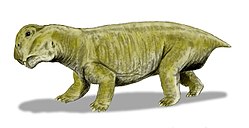| Myosauroides Temporal range: | |
|---|---|
| Scientific classification | |
| Kingdom: | Animalia |
| Phylum: | Chordata |
| Clade: | Synapsida |
| Clade: | Therapsida |
| Clade: | † Anomodontia |
| Clade: | † Dicynodontia |
| Family: | † Myosauridae |
| Genus: | † Myosauroides Broom, 1941 |
| Species: | †M. minnaari |
| Binomial name | |
| †Myosauroides minnaari Broom, 1941 | |
Myosauroides is an extinct genus of non-mammalian synapsid. It is found only at Kleinfontein, Graaff-Reinet (Cistecephalus Assemblage Zone). [1]





